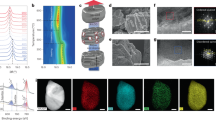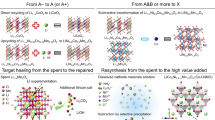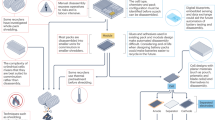Abstract
The rapid acceleration of global electrification has increased demand for sustainable energy storage, making lithium-ion batteries (LIBs) essential for various applications. However, their limited lifespan presents challenges related to resource waste and environmental risks. Unlike traditional metallurgical methods, which extract key metals from spent cathodes, the direct recycling process repairs damaged materials, maximizing their residual value through effective treatments. Despite widespread interest, systematic protocols to guide interdisciplinary researchers in direct recycling studies remain scarce. Using spent LiMn2O4 as an example, this protocol outlines a general approach for direct recycling and upcycling of spent LIBs. Initially, the failure condition of the spent cathode is evaluated using X-ray diffraction and inductively coupled plasma analysis to determine appropriate recycling parameters. The resulting recycled products include regenerated LiMn2O4 and upcycled next-generation cathode materials, such as high-voltage LiNi0.5Mn1.5O4 and Co-free, Li-rich Li1.2Ni0.2Mn0.6O2. Subsequently, electron microscopy, spectroscopic techniques and electrochemical performance tests evaluate recycling effectiveness. This protocol incorporates two representative recycling methods to provide readers with a detailed procedural guide. Solid-phase regeneration forms the basis of most direct recycling technologies; thus, it requires minimal adjustments for broad applicability. Joule heating, a more emerging recycling technology, leverages rapid nonequilibrium reactions, substantially reducing processing time and introducing beneficial structural defects and elemental gradient distributions within the material. Compared to metallurgical methods, solid-phase and Joule heating-based protocols reduce recycling time to ~32 h and 5 h, respectively. Overall, this protocol provides a reliable guide for researchers, promoting sustainable LIB recycling and advancing clean energy research.
Key points
-
This protocol introduces two representative techniques to help readers easily adapt and optimize the methods for implementing a direct recycling process.
-
The success of direct recycling hinges on thorough pretreatment and addressing the challenges posed by the failure behavior of spent materials, including lithium replenishment and phase structure recovery.
-
The core of direct upcycling lies in constructing a viable direct phase evolution path between the target and initial materials.
This is a preview of subscription content, access via your institution
Access options
Access Nature and 54 other Nature Portfolio journals
Get Nature+, our best-value online-access subscription
$32.99 / 30 days
cancel any time
Subscribe to this journal
Receive 12 print issues and online access
$259.00 per year
only $21.58 per issue
Buy this article
- Purchase on SpringerLink
- Instant access to full article PDF
Prices may be subject to local taxes which are calculated during checkout









Similar content being viewed by others
Data availability
All of the data supporting this research are available in the main text and the Supplementary Information, and original data can be obtained from the corresponding authors upon reasonable request. Source data are provided with this paper. Other data supporting the findings of this study were previously published28,35,46,48. Source data are provided with this paper.
References
Fuso Nerini, F. et al. Mapping synergies and trade-offs between energy and the Sustainable Development Goals. Nat. Energy 3, 10–15 (2018).
Soergel, B. et al. A sustainable development pathway for climate action within the UN 2030 agenda. Nat. Clim. Change 11, 656–664 (2021).
Li, M., Lu, J., Chen, Z. & Amine, K. 30 years of lithium-ion batteries. Adv. Mater. 30, 1800561 (2018).
Yang, X., Liu, T. & Wang, C. Thermally modulated lithium iron phosphate batteries for mass-market electric vehicles. Nat. Energy 6, 176–185 (2021).
Huang, Y. & Li, J. Key challenges for grid-scale lithium-ion battery energy storage. Adv. Energy Mater. 12, 2202197 (2022).
Lu, D. et al. Ligand-channel-enabled ultrafast Li-ion conduction. Nature 627, 101–107 (2024).
Ji, H., Wang, J., Ma, J., Cheng, H.-M. & Zhou, G. Fundamentals, status and challenges of direct recycling technologies for lithium ion batteries. Chem. Soc. Rev. 52, 8194–8244 (2023).
Wang, J. et al. Toward direct regeneration of spent lithium-ion batteries: a next-generation recycling method. Chem. Rev. 124, 2839–2887 (2024).
Wang, G. et al. Advances and challenges in thermal runaway modelling of lithium-ion batteries. Innovation 5, 100624 (2024).
Wang, Z., Zhang, B. & Guan, D. Take responsibility for electronic-waste disposal. Nature 536, 23–25 (2016).
Bauer, C. et al. Charging sustainable batteries. Nat. Sustain. 5, 176–178 (2022).
Gent, W. E., Busse, G. M. & House, K. Z. The predicted persistence of cobalt in lithium-ion batteries. Nat. Energy 7, 1132–1143 (2022).
Sun, X., Ouyang, M. & Hao, H. Surging lithium price will not impede the electric vehicle boom. Joule 6, 1738–1742 (2022).
Harper, G. et al. Recycling lithium-ion batteries from electric vehicles. Nature 575, 75–86 (2019).
Harper, G. D. J. Upcycle for enhanced performance. Nat. Sustain. 6, 725–726 (2023).
Chen, W. et al. Recycling lithium-ion batteries from electric vehicles. Sci. Adv. 9, eadh5131 (2023).
Tran, M. K., Rodrigues, M.-T. F., Kato, K., Babu, G. & Ajayan, P. M. Deep eutectic solvents for cathode recycling of Li-ion batteries. Nat. Energy 4, 339–345 (2019).
Cao, Y. et al. A review of direct recycling methods for spent lithium-ion batteries. Energy Storage Mater. 70, 103475 (2024).
Tao, Y., Rahn, C. D., Archer, L. A. & You, F. Second life and recycling: energy and environmental sustainability perspectives for high-performance lithium-ion batteries. Sci. Adv. 7, eabi7633 (2021).
Ciez, R. E. & Whitacre, J. F. Examining different recycling processes for lithium-ion batteries. Nat. Sustain. 2, 148–156 (2019).
Lan, Y. et al. Direct regenerating cathode materials from spent lithium-ion batteries. Adv. Sci. 11, 2304425 (2024).
Frith, J. T., Lacey, M. J. & Ulissi, U. A non-academic perspective on the future of lithium-based batteries. Nat. Commun. 14, 420 (2023).
Ren, H. et al. Densification of cathode/electrolyte interphase to enhance reversibility of LiCoO2 at 4.65 V. Adv. Mater. 36, 2408875 (2024).
Xue, H. et al. In situ conversion of artificial proton-rich shell to inorganic maskant toward stable single-crystal Ni-rich cathode. Adv. Mater. 37, 2415860 (2025).
Xu, E. et al. Stress-induced anomalous lithiation plateau of LiFeyMn1-yPO4 over high-rate discharging. Adv. Energy Mater. 15, 2404929 (2025).
Zhu, X. et al. Epitaxial growth of an atom-thin layer on a LiNi0.5Mn1.5O4 cathode for stable Li-ion battery cycling. Nat. Commun. 13, 1565 (2022).
Liu, T. et al. Origin of structural degradation in Li-rich layered oxide cathode. Nature 606, 305–312 (2022).
Wang, J. et al. Sustainable upcycling of spent LiCoO2 to an ultra-stable battery cathode at high voltage. Nat. Sustain. 6, 797–805 (2023).
Zheng, N. et al. Surface catalytic repair for the efficient regeneration of spent layered oxide cathodes. J. Am. Chem. Soc. 146, 27819–27829 (2024).
Ji, G. et al. Direct regeneration of degraded lithium-ion battery cathodes with a multifunctional organic lithium salt. Nat. Commun. 14, 584 (2023).
Tang, D. et al. A multifunctional amino acid enables direct recycling of spent LiFePO4 cathode material. Adv. Mater. 36, 2309722 (2024).
Jia, K. et al. Topotactic transformation of surface structure enabling direct regeneration of spent lithium-ion battery cathodes. J. Am. Chem. Soc. 145, 7288–7300 (2023).
Wang, J. et al. Direct and green repairing of degraded LiCoO2 for reuse in lithium-ion batteries. Natl Sci. Rev. 9, nwac097 (2022).
Ma, J. et al. Adaptable eutectic salt for the direct recycling of highly degraded layer cathodes. J. Am. Chem. Soc. 144, 20306–20314 (2022).
Wang, J. et al. Direct recycling of spent cathode material at ambient conditions via spontaneous lithiation. Nat. Sustain. 7, 1283–1293 (2024).
Shi, R. et al. Homogeneous repair of highly degraded Ni‐rich cathode material with spent lithium anode. Adv. Mater. 36, 2311553 (2024).
Zhuang, Z. et al. Fast Li replenishment channels‐assisted recycling of degraded layered cathodes with enhanced cycling performance and thermal stability. Adv. Mater. 36, 2313144 (2024).
Li, J. et al. Interfacial metal‐solvent chelation for direct regeneration of LiFePO4 cathode black mass. Adv. Mater. 37, 2414235 (2025).
Chen, W. et al. Efficient and scalable direct regeneration of spent layered cathode materials via advanced oxidation. Adv. Mater. 37, 2414235 (2025).
Choi, C. H. et al. Flash-within-flash synthesis of gram-scale solid-state materials. Nat. Chem. 16, 1831–1837 (2024).
Wang, C. et al. A general method to synthesize and sinter bulk ceramics in seconds. Science 369, 521–526 (2020).
Zhu, W. et al. Ultrafast non-equilibrium synthesis of cathode materials for Li-ion batterie. Adv. Mater. 35, 2208974 (2023).
Guo, Z. et al. Ultrafast non-equilibrium phase transition induced twin boundaries of spinel lithium manganate. Adv. Energy Mater. 14, 2302484 (2024).
Guo, Y. et al. Atomistic observation and transient reordering of antisite Li/Fe defects toward sustainable LiFePO4. Energy Environ. Sci. 17, 7749–7761 (2024).
Yin, Y. et al. Rapid, direct regeneration of spent LiCoO2 cathodes for Li-ion batteries. ACS Energy Lett. 8, 3005–3012 (2023).
Ji, H. et al. Closed‐loop direct upcycling of spent Ni‐rich layered cathodes into high‐voltage cathode materials. Adv. Mater. 36, 2407029 (2024).
Ji, G. et al. Sustainable upcycling of mixed spent cathodes to a high-voltage polyanionic cathode material. Nat. Commun. 15, 4086 (2024).
Ma, J. et al. Subtractive transformation of cathode materials in spent Li-ion batteries to a low-cobalt 5 V-class cathode material. Nat. Commun. 15, 1046 (2024).
Liu, S. et al. Manganese-based composite-structure cathode materials for sustainable batteries. Adv. Energy Mater. 15, 2404459 (2025).
Song, J. et al. Building better full manganese-based cathode materials for next-generation lithium-ion batteries. Electrochem. Energy Rev. 6, 20 (2023).
Gupta, V. et al. Scalable direct recycling of cathode black mass from spent lithium-ion batteries. Adv. Energy Mater. 13, 2203093 (2023).
Tao, S. et al. Collaborative and privacy-preserving retired battery sorting for profitable direct recycling via federated machine learning. Nat. Commun. 14, 8032 (2023).
Tao, S. et al. Generative learning assisted state-of-health estimation for sustainable battery recycling with random retirement conditions. Nat. Commun. 15, 10154 (2024).
Chen, Z. et al. Reaction-passivation mechanism driven materials separation for recycling of spent lithium-ion batteries. Nat. Commun. 14, 4649 (2023).
Ji, H. et al. Surface engineering suppresses the failure of biphasic sodium layered cathode for high performance sodium‐ion batteries. Adv. Funct. Mater. 32, 2109319 (2022).
Zhang, Y. et al. Operando characterization and regulation of metal dissolution and redeposition dynamics near battery electrode surface. Nat. Nanotechnol. 19, 790–797 (2023).
Zeng, W. et al. Entropy-increased LiMn2O4-based positive electrodes for fast-charging lithium metal batteries. Nat. Commun. 15, 7371 (2024).
Liu, T. et al. Correlation between manganese dissolution and dynamic phase stability in spinel-based lithium-ion battery. Nat. Commun. 10, 4721 (2019).
Tan, Y. et al. Overlithiation-driven structural regulation of lithium nickel manganese oxide for high-performance battery cathode. Energy Storage Mater. 63, 102962 (2023).
Dong, Q., Hu, S. & Hu, L. Electrothermal synthesis of commodity chemicals. Nat. Chem. Eng. 1, 680–690 (2024).
Wang, R. et al. Twin boundary defect engineering improves lithium-ion diffusion for fast-charging spinel cathode materials. Nat. Commun. 12, 3085 (2021).
Zhang, Y. et al. Oxygen vacancy chemistry in oxide cathodes. Chem. Soc. Rev. 53, 3302–3326 (2024).
Zhang, X. et al. Surface nickel gradient tunes anionic redox activity to stabilize cobalt-free Li-rich cathodes. Nano Energy 128, 109973 (2024).
Wang, K. et al. Unraveling the role of surficial oxygen vacancies in stabilizing Li-rich layered oxides. Adv. Energy Mater. 13, 2301216 (2023).
Acknowledgements
G.Z. was supported by the Guangdong Innovative and Entrepreneurial Research Team Program (grant no. 2021ZT09L197), Shenzhen Science and Technology Program (grant no. KQTD20210811090112002), the Interdisciplinary Research and Innovation Fund of Tsinghua Shenzhen International Graduate School and the Tsinghua Shenzhen International Graduate School-Shenzhen Pengrui Young Faculty Program of Shenzhen Pengrui Foundation (grant no. SZPR2023007). H.J. was supported by the National Natural Science Foundation of China (grant no. 524B2023). J.W. was supported by the Startup Fund for Young Faculty at Shanghai Jaio Tong University (grant no. 23×010502206) and the National Natural Science Youth Fund (grant no. 52302285).
Author information
Authors and Affiliations
Contributions
H.J., J.W., G.Z. and H.-M.C. conceived the idea and provided design guidelines. H.J. and J.W. performed the relevant experiments and data analysis with the help of X.Q., H.R., H.X., H.Z. and G.J. All authors discussed and contributed to the results. H.J. wrote the manuscript with comments and revisions from all the authors.
Corresponding authors
Ethics declarations
Competing interests
The authors declare no competing interests.
Peer review
Peer review information
Nature Protocols thanks Hao Luo and Min-Sik Park for their contribution to the peer review of this work.
Additional information
Publisher’s note Springer Nature remains neutral with regard to jurisdictional claims in published maps and institutional affiliations.
Key references
Wang, J. et al. Nat. Sustain. 7, 1283–1293 (2024): https://doi.org/10.1038/s41893-024-01412-9
Wang, J. et al. Nat. Sustain. 6, 797–805 (2023): https://doi.org/10.1038/s41893-023-01094-9
Ma, J. et al. Nat. Commun. 15, 1046 (2024): https://doi.org/10.1038/s41467-024-45091-8
Choi, C. H. et al. Nat. Chem. 16, 1831–1837 (2024): https://doi.org/10.1038/s41557-024-01598-7
Wang, C. et al. Science 369, 521–526 (2020): https://doi.org/10.1126/science.aaz7681
Supplementary information
Supplementary Information
Supplementary Figs. 1–15 and Tables 1–10.
Source data
Source Data Fig. 3
Statistical source data.
Source Data Fig. 4
Statistical source data.
Source Data Fig. 5
Statistical source data.
Source Data Fig. 6
Statistical source data.
Source Data Fig. 7
Statistical source data.
Source Data Fig. 8
Statistical source data.
Source Data Fig. 9
Statistical source data.
Rights and permissions
Springer Nature or its licensor (e.g. a society or other partner) holds exclusive rights to this article under a publishing agreement with the author(s) or other rightsholder(s); author self-archiving of the accepted manuscript version of this article is solely governed by the terms of such publishing agreement and applicable law.
About this article
Cite this article
Ji, H., Wang, J., Qiu, X. et al. A universal protocol for ultrafast direct regeneration and upcycling of spent lithium-ion battery cathode materials. Nat Protoc (2025). https://doi.org/10.1038/s41596-025-01234-9
Received:
Accepted:
Published:
DOI: https://doi.org/10.1038/s41596-025-01234-9



